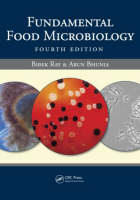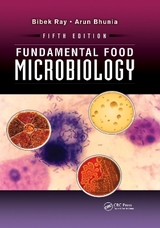
Fundamental Food Microbiology, Fourth Edition
Crc Press Inc (Verlag)
978-0-8493-7529-3 (ISBN)
- Titel erscheint in neuer Auflage
- Artikel merken
Maintaining the high standard set by the previous bestselling editions, Fundamental Food Microbiology, Fourth Edition presents the most up-to-date information in this rapidly growing and highly dynamic field. Revised and expanded to reflect recent advances, this edition broadens coverage of foodborne diseases to include many new and emerging pathogens, as well as descriptions of the mechanism of pathogenesis. An entirely new chapter on detection methods appears with evaluations of advanced rapid detection techniques using biosensors and nanotechnology. With the inclusion of many more easy-to-follow figures and illustrations, this text provides a comprehensive introductory source for undergraduates, as well as a valuable reference for graduate level and working professionals in food microbiology or food safety. Each chapter within the text’s seven sections contains an introduction as well as a conclusion, references, and questions. Beginning with the history and development of the field, Part I discusses the characteristics and sources of predominant food microorgasnisms and their significance. Part II introduces microbial foodborne diseases, their growth and influencing factors, metabolism, and sporulation. The third Part explains the beneficial uses of microorganisms in starter cultures, biopreservation, bioprocessing, and probiotics.
Part IV deals with food spoilage and methods of detection, followed by a discussion in Part V of foodborne pathogens associated with intoxication, infections, and toxicoinfections. Part VI reviews control methods with chapters on control of microbial access and removal by heat, organic acids, physical means, and combinations of methods. The final section is an in-depth look at advanced and traditional methods of microbial detection and food safety. Four appendices provide additional details on food equipment and surfaces, predictive modeling, regulatory agencies, and hazard analysis critical control points.
Introduction to Microbes in Foods
History and Development of Food Microbiology
Introduction
Discovery of Microorganisms
Where are they Coming From?
What are their Functions?
Development of Early Food Microbiology (Before A.D. 1900)
Food Microbiology: Current Status
Food Microbiology and Food Microbiologists
Characteristics of Predominant Microorganisms in Food
Introduction
Classification of Microorganisms
Nomenclature
Morphology and Structure of Microorganisms in Foods
Important Microorganisms in Food
Important Viruses
Important Bacterial Genera
Important Bacterial Groups in Foods
Sources of Microorganisms in Foods
Introduction
Predominant Microorganisms in Different Sources
Normal Microbiological Quality of Foods and Its Significance
Introduction
Raw and Ready-to-eat Meat Products
Raw and Pasteurized Milk
Shell Egg and Liquid Egg
Fish and Shellfish
Vegetables, Fruits, and Nuts
Cereal, Starches, and Gums
Canned Foods
Sugars and Confectioneries
Soft Drinks, Fruit and Vegetable Drinks, Juices, and Bottled Water
Mayonnaise and Salad Dressings
Spices and Condiments
Microbial Foodborne Diseases
Microbial Growth Characteristics
Introduction
Microbial Reproduction or Growth
Nature of Microbial Growth in Food
Factors Influencing Microbial Growth in Food
Introduction
Intrinsic Factors or Food Environment
Extrinsic Factors
Microbial Metabolism of Food Components
Introduction
Respiration and Fermentation during Growth
Metabolism of Food Carbohydrates
Degradation of Polysaccharides
Microbial Sporulation and Germination
Introduction
Mold Spores
Yeast Spores
Bacterial Spores
Importance of Spores in Food
Beneficial Uses of Microorganisms in Food
Microbial Stress Response in the Food Environment
Introduction
Stress Adaptation
Sublethal Stress and Injury
Viable-but-Nonculturable
Proponent Views
Microorganisms Used in Food Fermentation
Introduction
Microbiology of Fermented Foods
Lactic Starter Cultures
Other Starter Cultures
Yeasts and Molds
Biochemistry of Some Beneficial Traits
Introduction
Mechanisms of Transport of Nutrients
Transport and Metabolism of Carbohydrates
Transport and Metabolism of Proteinaceous Compounds and Amino Acids
Transport and Metabolism of Lipid Compounds
Genetics of Some Beneficial Traits
Introduction
Plasmids and Plasmid-Linked Traits in Starter-Culture Bacteria
Gene Transfer Methods in Starter-Culture Bacteria
Gene Cloning
Genome Mapping and Sequencing
Starter Cultures and Bacteriophages
Introduction
History
Concentrated Cultures
Starter-Culture Problems
Yeast and Mold Cultures
Microbiology of Fermented Food
Introduction
General Method of Production
Fermented Dairy Products
Fermented Meat Products
Fermented Vegetable Products
Intestinal Beneficial Bacteria
Introduction
Microbiology of the Human GI Tract
Important Characteristics of Beneficial Bacteria
Beneficial Effects of Probiotics
Some Aspects to Consider
Current Developments
Food Biopreservatives of Microbial Origin
Introduction
Viable Cells of Lactic Acid Bacteria as Preservatives
Organic Acids, Diacetyl, Hydrogen Peroxide, and Reuterine as Food Preservatives
Bacteriocins of Lactic Acid Bacteria as Food Preservatives
Yeast Metabolites as Preservatives
Food Ingredients and Enzymes of Microbial Origin
Introduction
Microbial Proteins and Food Additives
Microbial enzymes in Food processing
Microbial Food Spoilage
Important Factors in Microbial Food Spoilage
Introduction
Sequence of Events
Significance of Microorganisms
Some Important Food Spoilage Bacteria
Significance of Foods
Spoilage of Specific Food Groups
Introduction
Fresh and Ready-To-Eat Meat Products
Eggs and Egg Products
Fish, Crustaceans, and Mollusks
Milk and Milk Products
Vegetables and Fruits
Soft Drinks, Fruit Juices and Preserves, and Vegetable Juices
Cereals and their Products
Liquid Sweeteners and Confectioneries
Mayonnaise, Salad Dressings, and Condiments
Fermented Foods
Canned Foods
New Food Spoilage Bacteria in Refrigerated Foods
Microorganisms that Grow in Refrigerated Foods (Psychotrophs)
Popularity of Refrigerated Foods
Microbiological Problems
Incidence of Spoilage of Vacuum-Packaged Refrigerated Food
Food Spoilage by Microbial Enzymes
Introduction
Characteristics of Heat-Stable Enzymes of Psychotrophic Bacteria
Spoilage of Foods with Heat-Stable Microbial Enzymes
Spoilage of Foods by Microbial Enzymes at Low Temperature
Indicators of Microbial Food Spoilage
Introduction
Microbiological Criteria
Chemical Criteria
Assay of Heat-Stable Enzymes
Microbial Foodborne Diseases
Important Facts in Foodborne Diseases
Introduction
Human Gastrointestinal Disorder
Epidemiological Aspects
Current Trends
Foodborne Intoxications
Introduction
Staphylococcal Intoxication
Botulism
Mycotoxicosis
Foodborne Infections
Introduction
Salmonellosis by Salmonella enterica
Listeriosis by Listeria monocytogenes
Pathogenic Escherichia coli
Shigellosis (Bacillary Dysentery) by Shigella spp
Campylobacteriosis by Campylobacter spp
Yersiniosis byYersinia enterocolitica
Gastroenteritis by Vibrio spp
Enteric Viruses
Other Foodborne Infections
Foodborne Toxicoinfections
Introduction
Clostridium perfringens Gastroenteritis
Bacillus cereus Gastroenteritis
Cholera
Escherichia coli Gastroenteritis
Opportunistic Pathogens, Parasites, and Algal Toxins
Introduction
Opportunistic Pathogens
Biogenic Amines
Algal Toxins
Parasites
New and Emerging Foodborne Pathogens
Introduction
Associated Factors
Miscellaneous Factors
Other Emerging Foodborne Pathogens of Concern
Indicators of Bacterial Pathogens
Introduction
Criteria for Ideal Indicators
Coliform Group
Enterobacteriaceae Group
Enterococcus Group
Control of Microorganisms in Foods
Control of Access (Cleaning and Sanitation)
Introduction
Objectives of Sanitation
Factors to Consider
Control by Physical Removal
Control by Heat
Introduction
Objectives
Mechanism of Thermal Inactivation
Influencing Factors
Nature of Food
Mathematical Expressions
Methods
Control by Low Temperature
Introduction
Objectives
Mechanisms of Cold Induced Inactivation
Influencing Factors
Methods
Control by Reduced Water Activity
Introduction
Objectives
Mechanism of Action
Influencing Factors
Nature of Microorganisms
Methods
Control by Low pH and Organic Acids
Introduction
Objectives
Mechanisms of Antimicrobial Action
Influencing Factors
Acids Used
Control by Modified Atmosphere (or Reducing O–R Potential)
Introduction
Objectives
Mechanism of Action
Influencing Factors
Methods
Control by Antimicrobial Preservatives
Introduction
Objectives
Influencing Factors
Examples of Antimicrobial Preservatives
H2O2
Control by Irradiation
Introduction
Objectives
Mechanisms of Antimicrobial Action
Influencing Factors
Methods
Control by Novel Processing Technologies
Introduction
Summary of Processing Methods
Pulsed Electric Field
Hydrostatic Pressure Processing
Control by a Combination of Methods (Hurdle Concept)
Introduction
Mechanisms of Antimicrobial Action
Current Status
Microbial Detection and Food Safety
Conventional and Biosensor Based Detection Methods for Microorganisms in Food and Food Environment
Introduction
Methods Used
Standard and Recommended Methods
Sampling for Microbial Analysis
Quantitative Methods for Microbial Enumeration in Foods
Qualitative Methods to Isolate Microorganisms in Foods
Test for Bacterial Toxins in Foods
Rapid Methods and Automation
Biosensors for Pathogen Detection
Appendix A: Microbial Attachment to Food and Equipment Surfaces
Importance
Mechanisms of Attachment
Influencing Factors
Control Measures
Appendix B: Predictive Modeling of Microbial Growth in Food
Importance
Traditional Methods
Predictive Microbiology
Appendix C: Regulatory Agencies Monitoring Microbiological Safety of Foods in the United States
Food Safety Regulations
The Agencies
Appendix D: Hazard Analysis Critical Control Points
Introduction
HACCP Principle of the NACMCF Index
| Erscheint lt. Verlag | 8.10.2007 |
|---|---|
| Zusatzinfo | 56 Tables, black and white; 64 Illustrations, black and white |
| Verlagsort | Bosa Roca |
| Sprache | englisch |
| Maße | 178 x 254 mm |
| Gewicht | 1134 g |
| Themenwelt | Naturwissenschaften ► Biologie ► Mikrobiologie / Immunologie |
| Technik ► Lebensmitteltechnologie | |
| ISBN-10 | 0-8493-7529-0 / 0849375290 |
| ISBN-13 | 978-0-8493-7529-3 / 9780849375293 |
| Zustand | Neuware |
| Haben Sie eine Frage zum Produkt? |
aus dem Bereich



